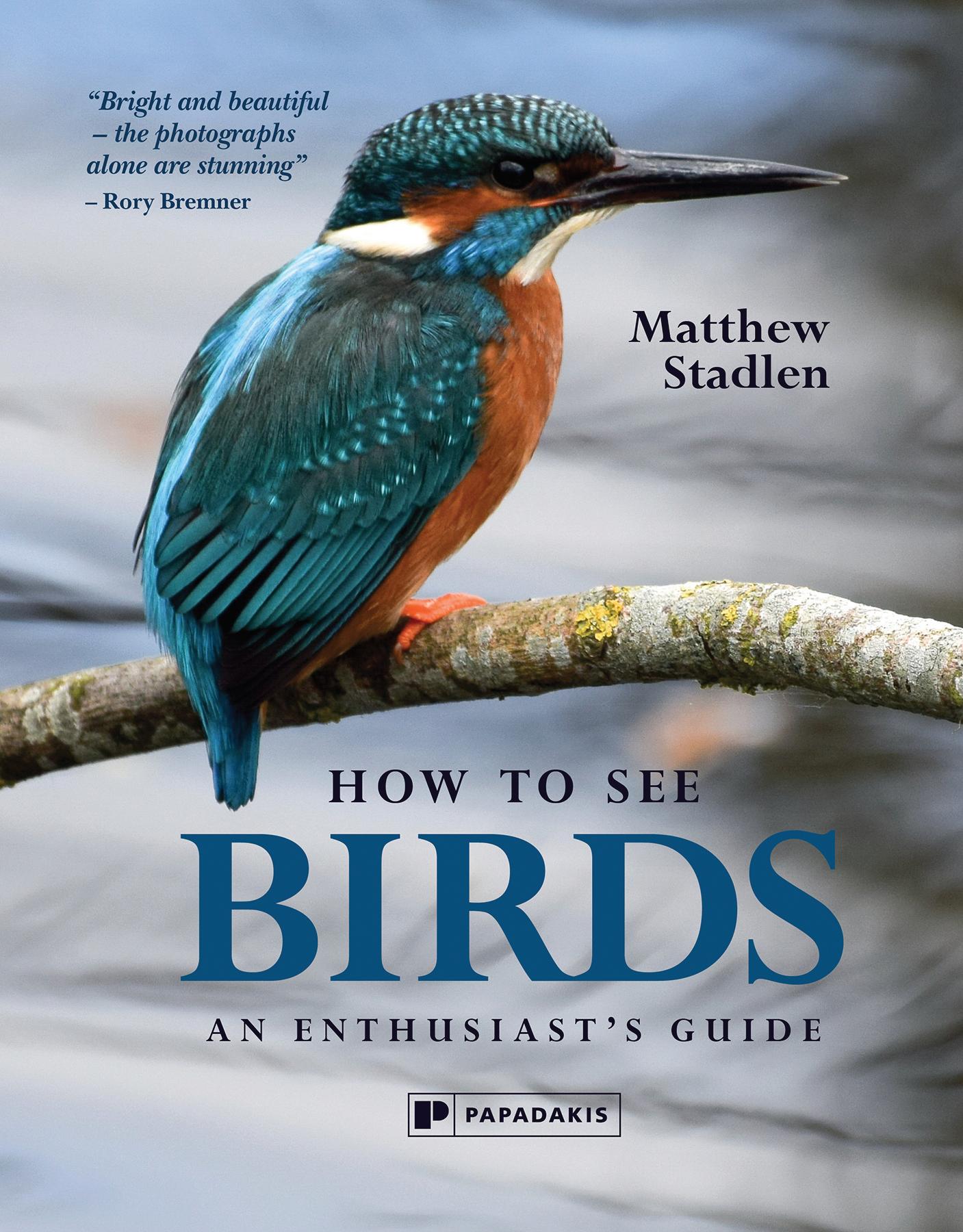
To David Howarth, my godfather and uncle, who helped inspire me to become a birdwatcher, and to my wife, Lily Walters, who has encouraged me in my birdwatching and photography and who now has a keen eye for a distant raptor.
– Matthew Stadlen
First published in Great Britain in 2019 by Papadakis Publisher
An imprint of Academy Editions Limited
Kimber Studio, Winterbourne, Berkshire, RG20 8AN, UK info@papadakis.net | www.papadakis.net

@papadakisbooks PapadakisPublisher

Publishing Director: Alexandra Papadakis
Design Director: Aldo Sampieri
Publishing Assistant: Megan Prudden
ISBN 978 1 906506 69 8
Copyright © 2019 Matthew Stadlen and Papadakis Publisher
All rights reserved.
Matthew Stadlen hereby asserts his moral right to be identified as the author of this work.
No part of this publication may be reproduced or transmitted in any form or by any means, electronic or mechanical, including photocopy, recording or any other information storage and retrieval system, without prior permission in writing from the Publisher.
A CIP catalogue of this book is available from the British Library
Printed and bound in China
front cover: Kingfisher, Rye Meads, Hertfordshire
back cover: Swee Waxbills, Kirstenbosch Botanical Gardens, Cape Town, South Africa
half title: Cuckoo, Thursley Common, Surrey
frontis: Lilac-breasted Roller, Masai Mara, Kenya
opposite: Orange-breasted Sunbird, Kirstenbosch Botanical Gardens, Cape Town, South Africa

 Foreword by Martin Harper
Foreword by Martin Harper
CONTENTS
Introduction Chapter 1: Garden Birds Coal Tit Blue Tit Goldfinch Siskin Robin Chaffinch Bullfinch Greenfinch Great Spotted Woodpecker Blackbird Ring-necked Parakeet Wood Pigeon Magpie Chapter 2: Countryside Birds Stonechat Sedge Warbler Linnet Whitethroat Nuthatch Meadow Pipit Yellowhammer Snow Bunting Common Starling Redwing Chough Chapter 3: Water Birds Kingfisher Grey Wagtail Atlantic Puffin Arctic Tern Black-headed Gull Sandwich Tern Whimbrel Greylag Goose Canada Goose Purple Heron Grey Heron Common Crane Mute Swan Chapter 4: Visitors Nightingale Waxwing Swallow Cuckoo Chapter 5: Foreign Birds Zitting Cisticola Southern Double-collared Sunbird 58 62 64 66 68 72 72 78 80 81 85 88 90 91 96 100 102 106 108 109 112 114 118 120 122 8 10 18 20 22 24 26 28 30 32 32 34 36 37 38 40 42 44 46 49 49 50 51 54 56
Rough-legged Buzzard
Red Kite
Short-toed Snake Eagle Black-chested Snake Eagle
Brown Snake Eagle
Little Bee-eater Striped Kingfisher Green Bee-eater European Bee-eater Blue-cheeked Bee-eater European Roller African Wattled Lapwing Lilac-breasted Roller African Penguin Marabou Stork Ostrich Chapter 6: Owls Little Owl Barn Owl
7: Birds of
Red-footed Falcon Kestrel
Orange-breasted Sunbird
Chapter
Prey
Montagu’s Harrier
Hen Harrier
Common Buzzard
Bateleur Tawny Eagle African Fish Eagle Golden Eagle White-tailed Eagle Lappet-faced Vulture Secretary Bird Index Bibliography Acknowledgements About the Author 176 178 180 181 182 184 188 190 191 192 192 130 132 134 136 136 137 137 140 142 152 154 154 156 158 158 160 162 162 164 164 166 168 170 175 175 175


COAL TIT (11.5cm)
Coal Tits are common. But – and there should be no need for a ‘but’ – the intricacies of their patterning and delicate shifts in their colouring demand our attention. Immediately distinguishable from their scarcer relatives the Marsh Tit and (rarer) Willow Tit (11.5cm) by the white nape that splits the black of their neck – and lacking the funky hairstyle of the Crested Tit (11.5cm) – they are pretty little birds. Catch them at a bird feeder in an RSPB hide on the picturesque banks of Lake Vyrnwy in Powys and they’ll dart nervously in and out of view. Not much bigger than a thickset thumb, they make their way between the heftier Chaffinches and more confident Siskins, determined to have their fill of the plentiful seeds.
Tiny acrobats among the branches, Coal Tits are perhaps most at home in conifer forests where they can be found hanging upside down to access food. But they’re adaptable creatures too, happy to nip in and steal seeds and nuts from garden feeders before storing them safely out of the reach of bigger, more dominant birds. In winter they can team up with other tits to form flocks in pursuit of something to eat. Look out for that black and white head and the cinnamon fringe to the underparts.

You don’t have to live near a Welsh lake to encounter a Coal Tit. In fact, you need not get up from your armchair, even if you are in the centre of a city, to join in the fun of birdwatching. Urban birding can be as rewarding as a stroll in the country. In my parents’ London garden I’ve spotted Green and Great Spotted Woodpecker, Wood and Feral Pigeon, House Sparrow, Blackbird, Blackcap, Greenfinch, Goldfinch, Grey Heron, Mute Swan, Canada Goose, Long-tailed Tit, Great Tit, Blue Tit, Song Thrush, Mistle Thrush, Crow, Robin and no doubt others that I’m forgetting.
Just up the road from my childhood home, no more than a hundred yards from the Ladbroke Grove traffic, I recently spent a shimmering spring afternoon watching a Coal Tit singing at the peak of its voice amid the cherry blossom. As I photographed the bird, its tiny body entombed in pink and invisible to most pedestrians, a delivery man wanted to know what on earth I was up to. Urban birdwatchers are understandably objects of curiosity, and we struck up a conversation. Twenty minutes later, I knew more about Islam than I had before setting out with my camera, and I’d made a new friend, too. Following a passion is contagious, often sparking the interest of others, and we can be at our most approachable when we’re lost in what we love.

21 Garden Birds
opposite: Coal Tit, Notting Hill, London
below left: Crested Tit, St Moritz, Switzerland
below right: Willow Tit, St Moritz, Switzerland

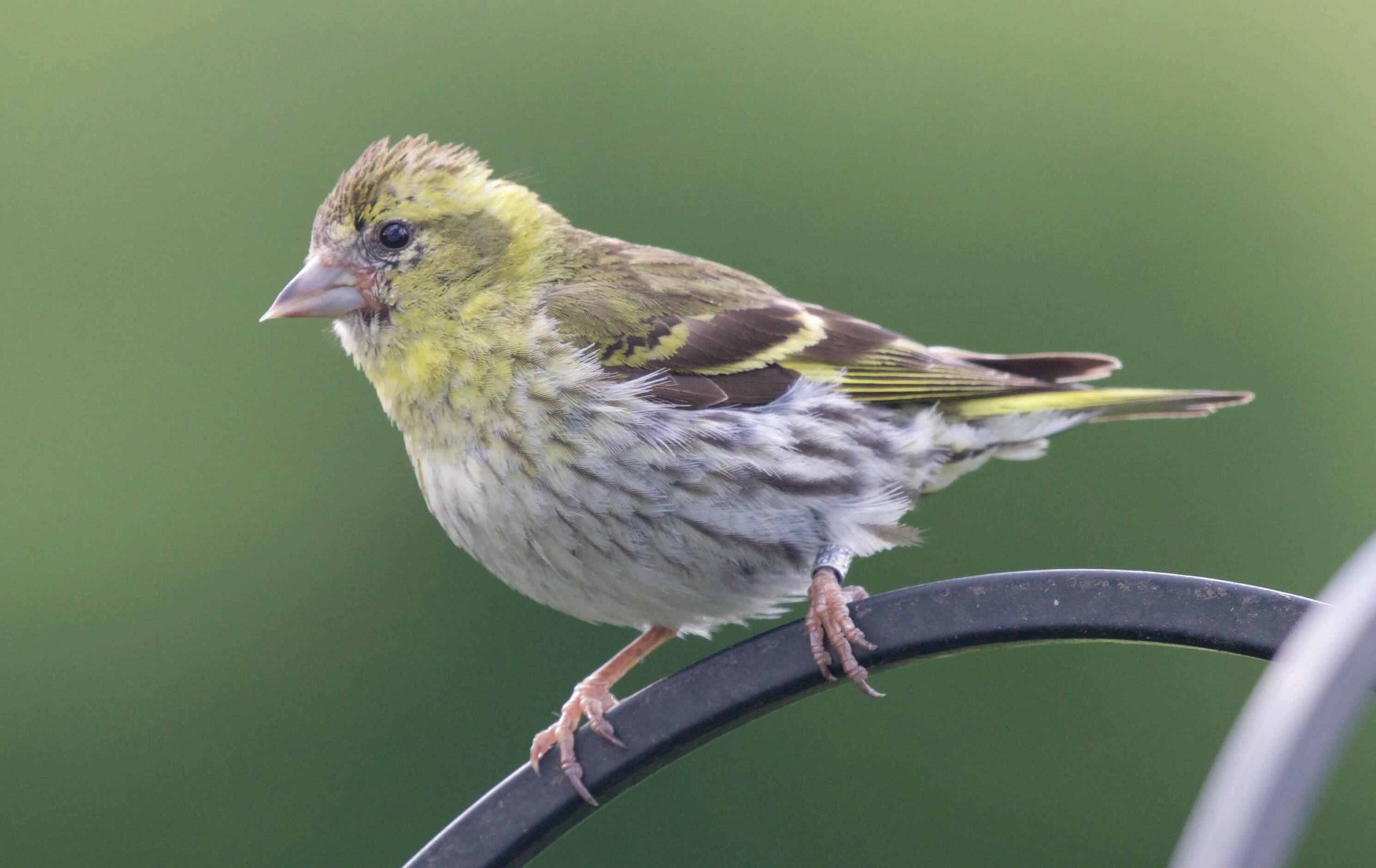

opposite: Siskin, Lake Vyrnwy, Mid Wales
below: Siskin, Powys, Mid Wales
SISKIN (12cm)
A bird I wanted but failed to see as a boy but that turned up at my mum’s feeders in Wales in my twenties or thirties. The male is a riot of yellows and greens with a prominent black crown; the female, also streaky in appearance, is duller and lacks the black on her head. I’ve now seen many of these petite finches, which are more common in Wales and Scotland than in England, and photographed several. The male I captured from an RSPB hide at Lake Vyrnwy has a ring on his leg which indicates that his movements are being tracked in a low tech way by someone with a licence to research bird behaviour. Look out for the forked tail and sharp beak that Siskins use to tear at seeds.
Siskins are not unlike Serins, although the latter are very rare in the UK and my sightings have been confined to France and maybe to Spain when I was on a trip through Andalucia with my father in my early teens. Only on my most recent holiday in the Luberon, where I’ve stayed with my family at the same dreamy villa almost every year for a decade, did I notice Serins singing energetically from the conifers and other outposts of the property. They were, however, too elusive to photograph up close, despite my best efforts in the heat, so I’ve made do with my pictures of Siskins here.

GREAT SPOTTED WOODPECKER (22-23cm)
The Great Spotted Woodpecker is an old friend from my childhood. A bird often heard before it’s seen, this is a species painted boldly in red, white and black. Look out for its bouncing flight and listen for the drumming sound male birds make during springtime as they mark their territory. You may also hear woodpeckers tapping repetitively on wood in search of insects, or in the process of creating a nest hole. I sat patiently at the bird table of a neighbour in Wales, with my long lens balancing on my knee, in the hope that one of the local woodpeckers would put in an appearance. Sure enough, a lovely looking bird came to feed, and I photographed it against the green light of a hot summer’s day. At least one of these woodpeckers visited my parents’ London garden when I was growing up and much more recently a handsome specimen was only just out of range of a sharp shot in Richmond Park. The male has a flash of red at the back of its head that the female lacks.
The Green Woodpecker (30-34cm) is noticeably bigger than the Great Spotted with a less exaggerated, undulating flight and was also a visitor to my parents’ communal garden during my childhood. I photographed one looking for worms in Kew Gardens in the autumn of 2018 when I was out searching – unsuccessfully – for the Golden Pheasants that, I’d learned from the Instagram feed of a close friend, had made the beauty spot their home. These woodpeckers are often to be seen feeding on the ground and I finally managed to capture the bird in one of the pools of sunlight afforded by a gap in the trees. Distinctive with its red crown, black face mask, green wings, pale chest and yellow rump, the Green Woodpecker isn’t exactly pretty up close but it is striking. The male has an extra sliver of red on the sides of its chin.

left: Green Woodpecker, Kew Gardens, London
opposite: Great Spotted Woodpecker, Powys, Mid Wales
overleaf left (page 36): Blackbird, Buckinghamshire
overleaf right (page 37): Ring-necked Parakeet, Kensington Gardens, London
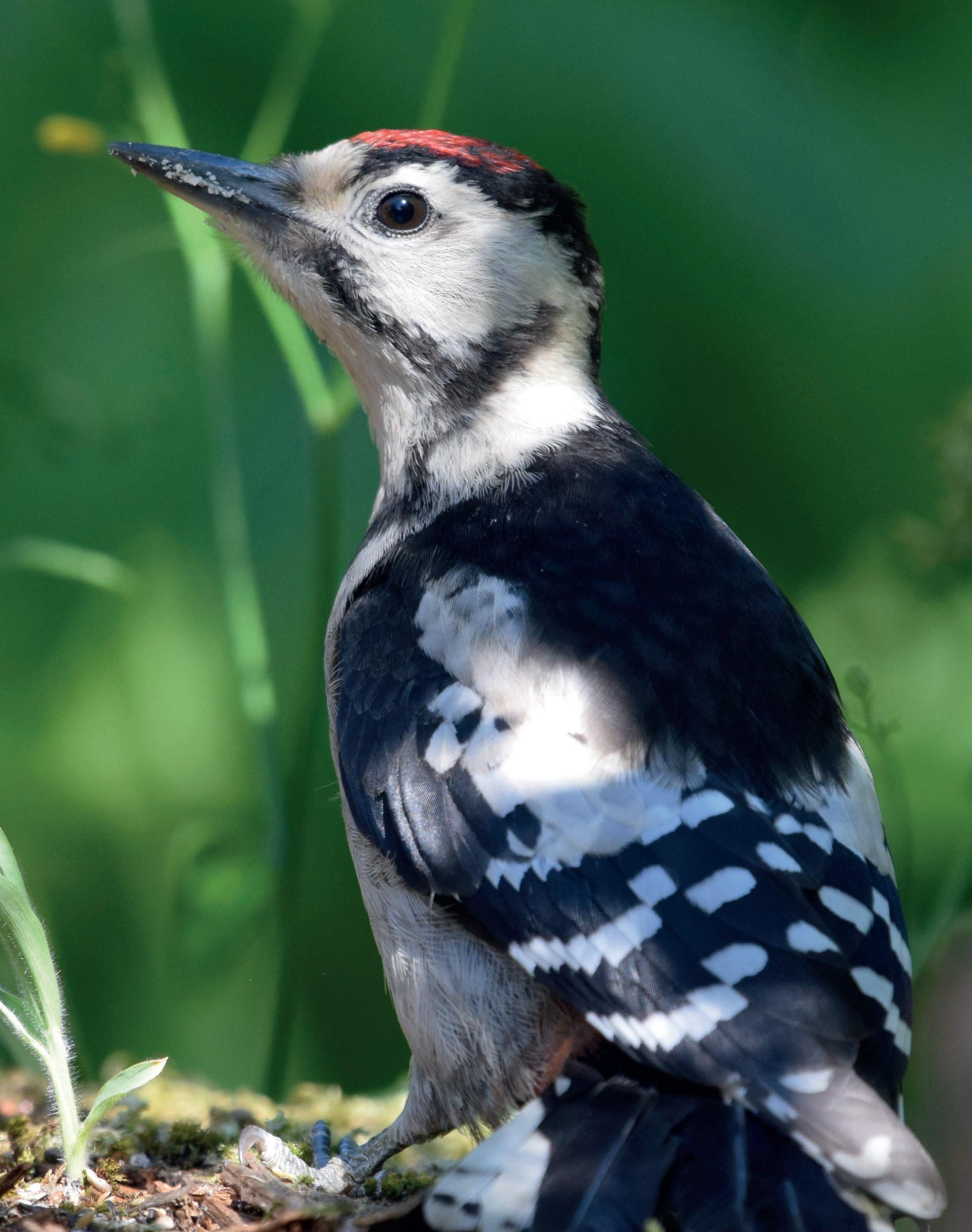
34 How To See Birds



CountrysideBirds
It’s so easy to take the British countryside for granted. Instead, why not revel in its beauty and proximity? If you’re a Londoner like me, you don’t have to head for the Scottish Highlands to immerse yourself in stunning landscapes. The Welsh hills are three hours away. Even closer are the fields and hedgerows of Buckinghamshire and Oxfordshire. And where there is countryside, there are birds. Sometimes fewer than you might expect – as we’ll see in the next chapter, water plays an important role in nourishing birdlife – but it is always worth keeping your eyes peeled and ears pricked for telltale signs of activity. An afternoon out birdwatching in the country can be re-energising – and good for the waistline too!
Wherever you live or travel to in the country, there will be many species to discover and, if you catch the bug, to photograph. But don’t make the mistake of ignoring common birds. Look closely and they can reveal astonishing beauty. Take the Pheasant (53-89cm) pictured opposite, for example. Isn’t he marvellous? I was out taking pictures of rarer species when he caught my eye with his bright red face, blue-green neck and russet waistcoat.
The Welsh hills, with their nooks and crannies, are particularly special to me and, although I can’t escape to them as often as I was once able to, I still visit at least four or five times a year. Resident Buzzards hunt the valley in front of my parents’ house and a Goshawk – a bird I still long to see for the first time – once nested in nearby woods. Red Kites are occasional visitors and Tawny Owls call out to one another after dark. Pied Flycatchers visit the tree-lined lanes in spring and my mother spent warm, sunny afternoons watching a Spotted Flycatcher feeding its young in the garden one summer not so long ago. House Martins used to make their homes in the eaves and Grey Wagtails occasionally wag their tails on the slate roof. Linnets, Bullfinches, and tiny Wrens and Goldcrests are all to be found in our local area, too, and I spotted and photographed my first Garden Warbler on the edge of local woodland.
43 Pheasant, Otmoor, Oxfordshire


52 How To See Birds



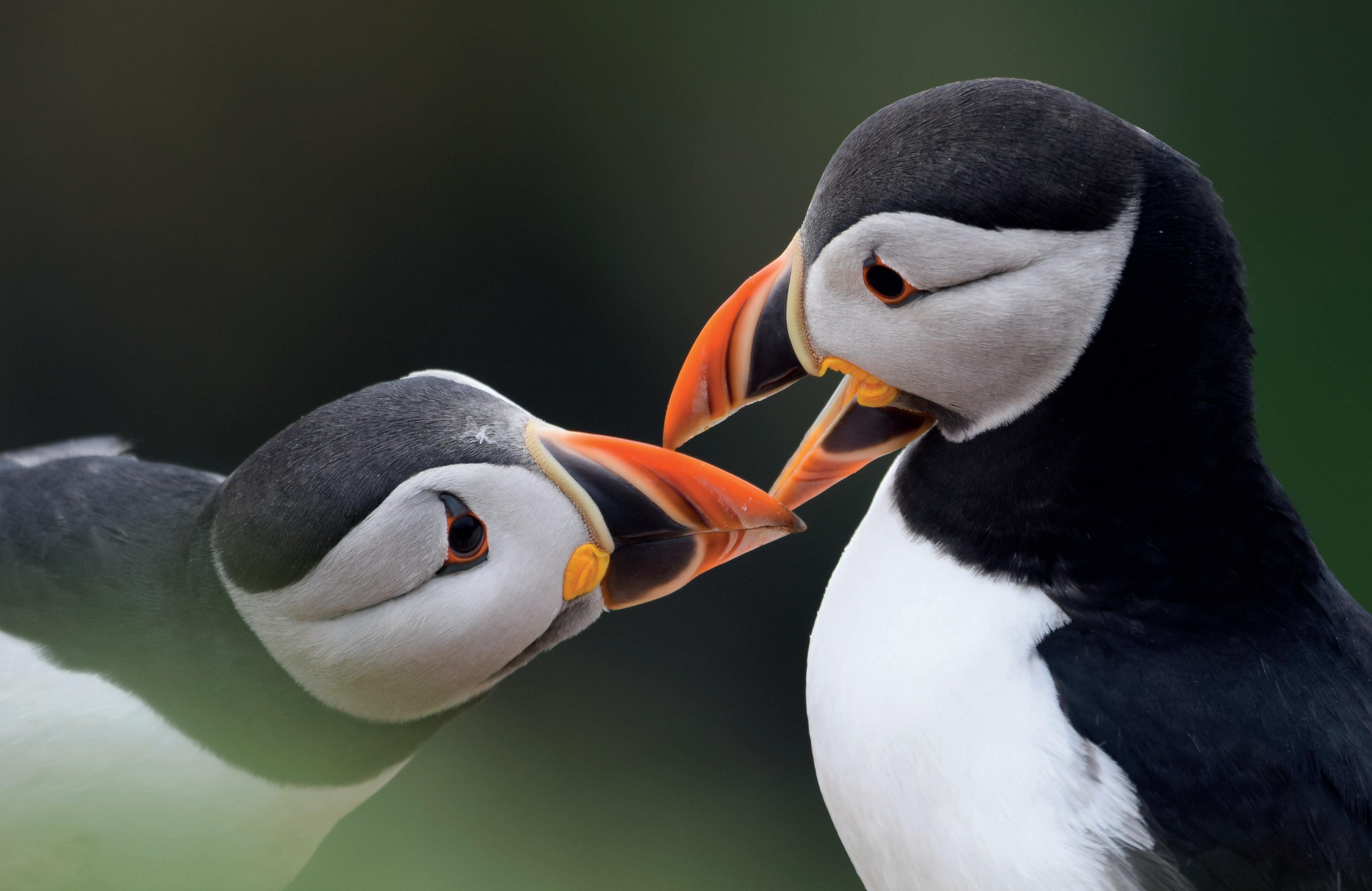

SOUTHERN DOUBLE-COLLARED SUNBIRD (12cm)
The Kirstenbosch Botanical Gardens nestle in the bosom of Table Mountain in one of the leafier suburbs of Cape Town. On a clear day, the views extend across to the waterfront and to the Atlantic Ocean. Even if you’re not a bird enthusiast, you can’t fail to see the beauty on display: an already spectacular location is bejewelled by flowerbeds flaming in reds, oranges and yellows. But for the bird photographer, the gardens are an even rarer treat, offering as they do stunning backdrops to some of South Africa’s most eye-catching pollen-feeders.
As I walked between the flowerbeds in the February heat, Cape Sugarbirds (34-44cm) , endemic to the Cape, perched on trees or clambered on sturdy flowers to access nectar with their long, sharp beaks and long, brush-tipped tongues. The male Sugarbirds have instantly recognisable tails that are comfortably longer than their bodies and that fan out at their tips. A territorial Cape Batis peered out at my lens from the long grass bordering one of the walkways and showed off its intricately patterned feathers; a Cape Bulbul straddled the stem and flowerhead of a colourful plant as it betrayed its yellow underbelly while looking at me with its pink-rimmed eye, and an omnivorous Red-winged Starling (27-30cm) did similar, while showing off its glossy black plumage (though not its chestnut wing feathers).
Speckled Mousebirds hung out in the bushes and close to the tops of trees. I’d seen this species a month earlier in Kenya, and came across a cluster of Red-faced Mousebirds (34cm) a few days later in the stunning gardens of the Babylonstoren hotel grounds. Frugivorous birds, Red-faced Mousebirds are a sociable species, when they’re not breeding, and feed in gangs. Although they are said to be more wary than other Mousebirds, I had no difficulty in approaching close enough for razor sharp shots of one of them tearing apart a juicy peach.
Back in the Kirstenbosch Botanical Gardens, the unspectacular but delightful African Dusky Flycatcher looked pretty against a golden, sun-soaked backdrop, as it paused in its pursuit of insects, and a yellowbrowed Forest Canary (12.5-13cm) , not to be confused with the similar looking Brimstone (or Bully) Canary, munched juicy seeds with its strong bill in the dappled shade. Caught in a halo of sunlight, its red bill illuminated, a Common Waxbill balanced on a green reed and showed off a prominent red band running across its eye, and the delicately drawn stripes curving round its underbody and back. In another corner of the gardens, I hoped desperately for its cousin, the miniature Swee Waxbill (9-10cm) , to show me both its startling red rump and red lower mandible at the same time. Eventually I happened upon a party of three of these dainty birds performing gymnastics on strands of long grass that bent but did not entirely give way under their weight. In one of my photographs it appears as if one of the birds is asking another for a bite of the tiny meal it carries in its beak.
To my huge disappointment and enduring frustration, however, I narrowly missed a sighting of what would have been my first Malachite Sunbird. A local couple had just watched a pair fly off as I approached. You’d be unlucky, though, in these gorgeous gardens not to see an almost equally arresting relative, the Southern Doublecollared Sunbird. The challenge I set myself was to photograph this multi-coloured nectar specialist with the sun on its chainmail feathers and, ideally, as it fed on a vibrant flower. I was in Cape Town for my brother’s wedding and persuaded my wife to let me visit the gardens three times in one week. By the end of the trip, I had what I wanted. But not without having to discard scores of unsuccessful images. Too dark! Out of focus! Partially obscured!
Southern Double-collared Sunbird, Kirstenbosch Botanical Gardens, Cape Town, South Africa

122 How To See Birds

WHITE-TAILED EAGLE (70-90cm)
From a very early age the White-tailed Eagle brought together everything that excited me about birds. Its monumental size together with its remote coastal habitat and the brilliant white of its head and tail, conjured something almost otherworldly in my young imagination. The species is now confined to remote parts of Scotland and it wasn’t until my mid-thirties that I finally took to the motorways south and north of the border in pursuit of this giant fish-eating raptor.
I strapped myself in on a brilliantly hot and sunny day in the country lanes of Montgomeryshire, where I’d stopped off en route, and the skies stayed blue all the way up to the ferry crossing from the mainland at Oban. What incredible luck! With my car safely stowed on the deck below, I filled my eyes with the island views as we headed for Mull, perhaps the most famous British home of the magnificent Whitetailed Eagle. The sun caught the waves as we made our approach and seabirds took advantage of the unusually balmy evening.
If you’ve never visited Mull – as I hadn’t – it immediately strikes you as a special place. After a modest night in a rural B&B, I drove, with the roof down on my old Volkswagen, through the island to Ulva, the tiny harbour that serves the outer islands. Sheep ambled dreamily across the road and the weather held fair. The bracken was thick and green and the sea a rich blue between the headlands.
For a decade now, Martin Keivers has developed a relationship with the eagles. He runs Mull Charters and feeds them out at sea from his boat, a Lochin 33, during the spring, summer and early autumn
months. Tourists assemble each morning near the quay. There were no guarantees – this is wildlife after all – but my hopes were high. All aboard, within minutes of the jetty Martin spotted a pair of White-tailed Eagles at home on one of the grassy outcrops of the neighbouring Isle of Ulva. Three decades in the making, this first sighting was an unforgettable experience.
Our trip just got better. Soon up to five birds took it in turns at intervals to circle our boat and pick their moment to plunge seawards towards the dead fish slung overboard. We were just metres from one of Scotland’s most treasured species. Some of the birds had been ringed so that their movements could be tracked by ornithologists keen to understand more about their behaviour. At least one hadn’t. Their eagle eyesight enables the birds to pick out the boat from miles away and we were treated to an astonishing display. Though there was perhaps something a little incongruous about such rare birds seeming so tame, the trust they had developed with Martin afforded us stunning opportunities to capture them in action.
The money shot, of course, is the moment the bird clutches the fish from the water. I didn’t manage that, but I captured the eagles low over the sea in a variety of poses.
The White-tailed Eagle was hunted to extinction in the UK during the early 20th century and those we’re lucky enough to enjoy today are the descendants of reintroduced birds. We must protect Britain’s biggest bird so that future generations can marvel at its mighty beauty.
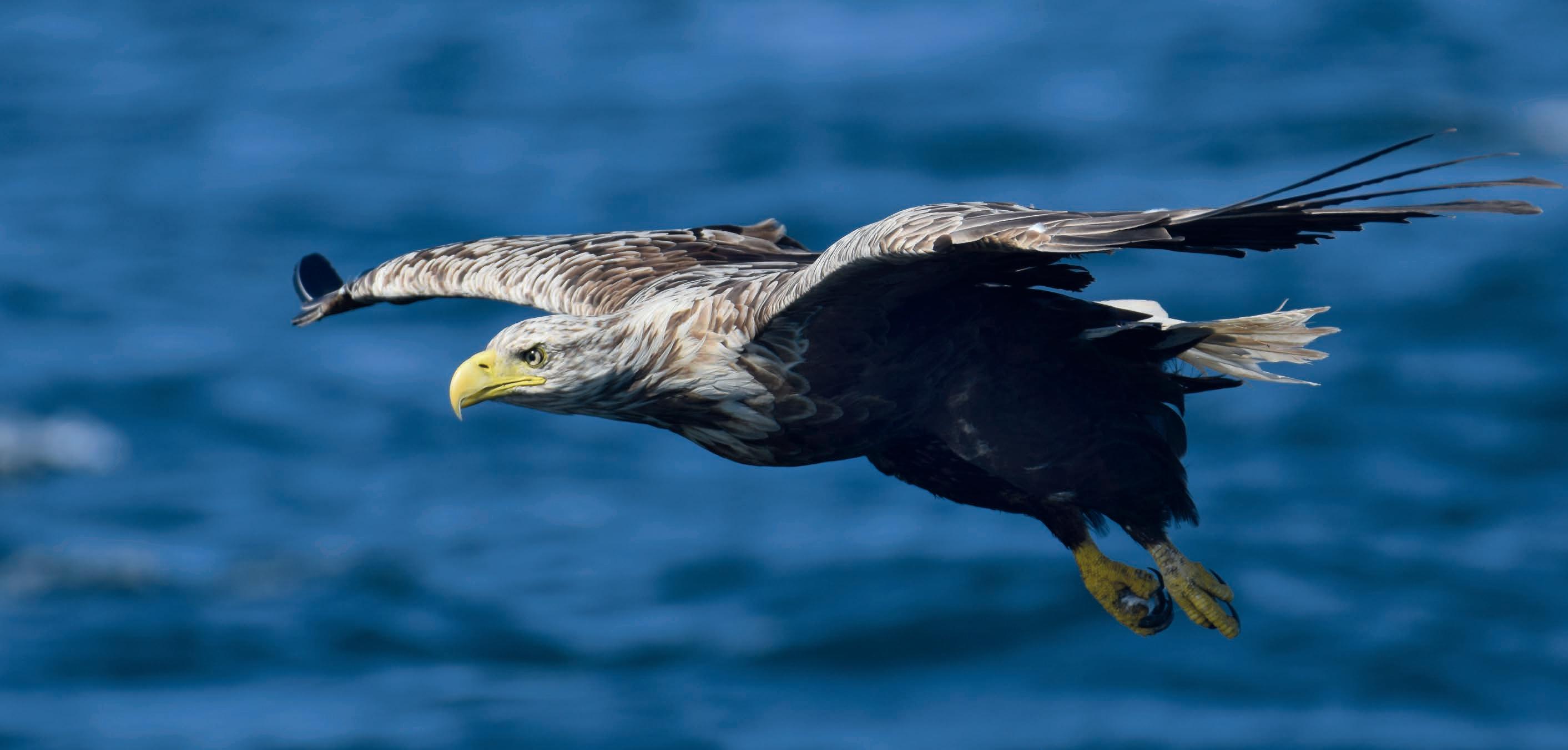
opposite: White-tailed Eagle, Isle of Mull, Scotland

182 How To See Birds


ACKNOWLEDGEMENTS
I would like first to thank my publisher and editor, Alexandra Papadakis. She believed in this book and in my passion for telling its story through photographs and words. Without her commitment to ambitious projects such as this, How To See Birds might never have happened. Together with her team - Aldo Sampieri and Megan Prudden - she has helped me to realise a dream. I’d also like to put on record my gratitude to my parents, Frances and Nick, who have always believed in me, supported me and encouraged me to fulfil my potential in whatever it is that I set my mind to. Both have championed my photography and love of nature. I am thankful, too, to my uncle and godfather, David Howarth, who took me to see my first Golden Eagle and Ospreys in
Scotland when I was just eight years old: he helped instil in me my love of birdwatching. It is important also to send thanks to all those who work so hard in this country to protect birds from the many threats they face and who encourage the rest of us to enjoy them responsibly. Special appreciation goes to Martin Harper, the Global Conservation Director of the RSPB, for his generous introduction. Our neighbour in Wales, Mike Haigh, does important bird-related work, has helped introduce me to new species and was kind enough to check through my writing - I am in his debt. Finally, and most of all, I’d like to thank my wife, Lily Walters, for celebrating who I am and for taking pleasure in the pleasure I take in watching and photographing birds.

Matthew Stadlen is a radio and television presenter. He began presenting on LBC in October 2016 and has achieved large national audiences for his weekend shows. He interviews famous names on stage at venues around the country and presents a podcast series for How To Academy
He presented, produced and co-devised the hugely successful Five Minutes With interview strand as well as 29 half hour On The Road With documentaries – both for the BBC, where he was also a programme editor on BBC One’ s This Week after starting out on Newsnight
Matthew made national and international headlines with his articles for The Telegraph and wrote The Matthew Stadlen Interview in the paper. He has written for The Sunday Times and Radio Times, The Independent and The Spectator, he has appeared frequently on Sky News and is the co-author of The Politics Companion, published in 2004.
Cambridge educated, Matthew was born and raised in Notting Hill where he still lives but he gets out to the country whenever he can to pursue his twin passions of photography and birdwatching. He has photographed over 200 species and seen around 900. Find him on Twitter and Instagram @matthewstadlen.
192 How To See Birds




 Foreword by Martin Harper
Foreword by Martin Harper





















